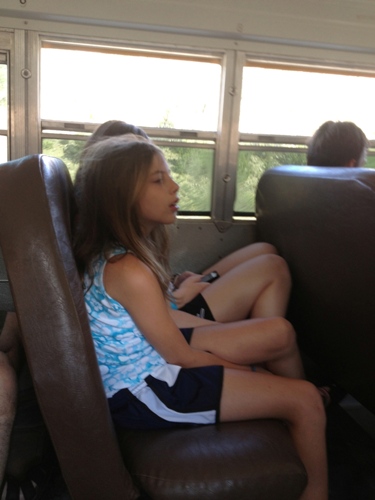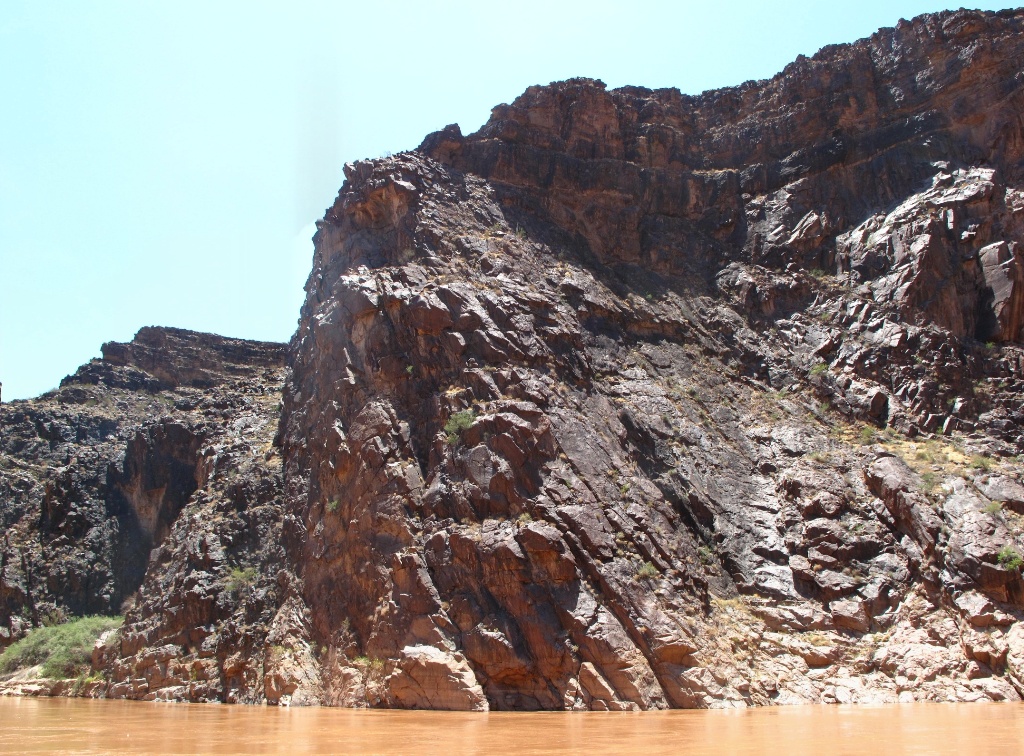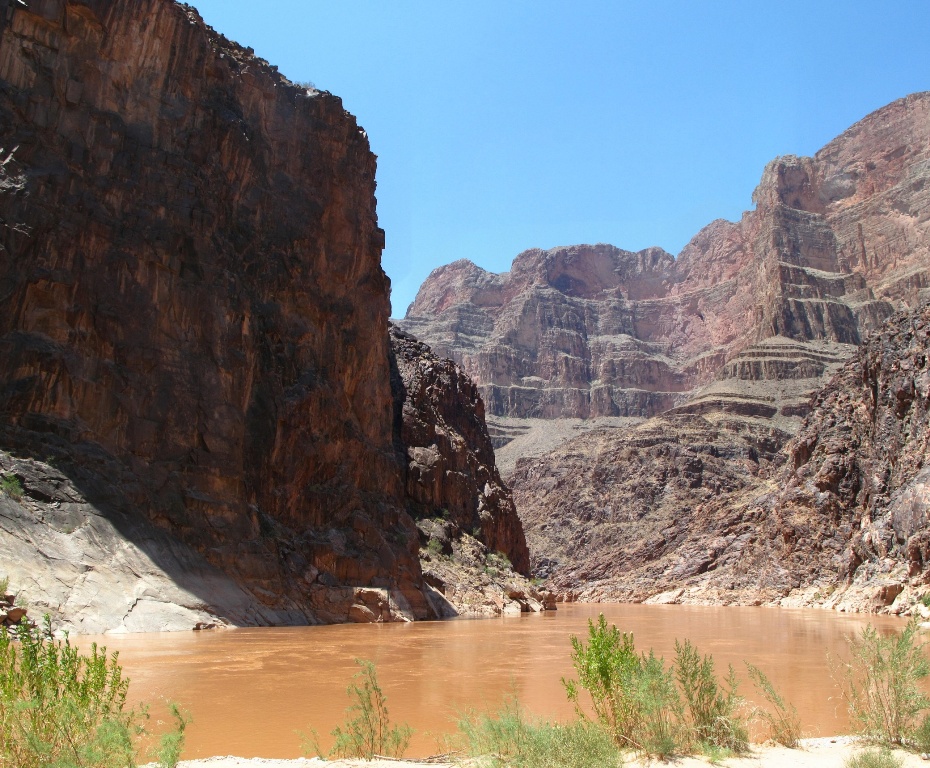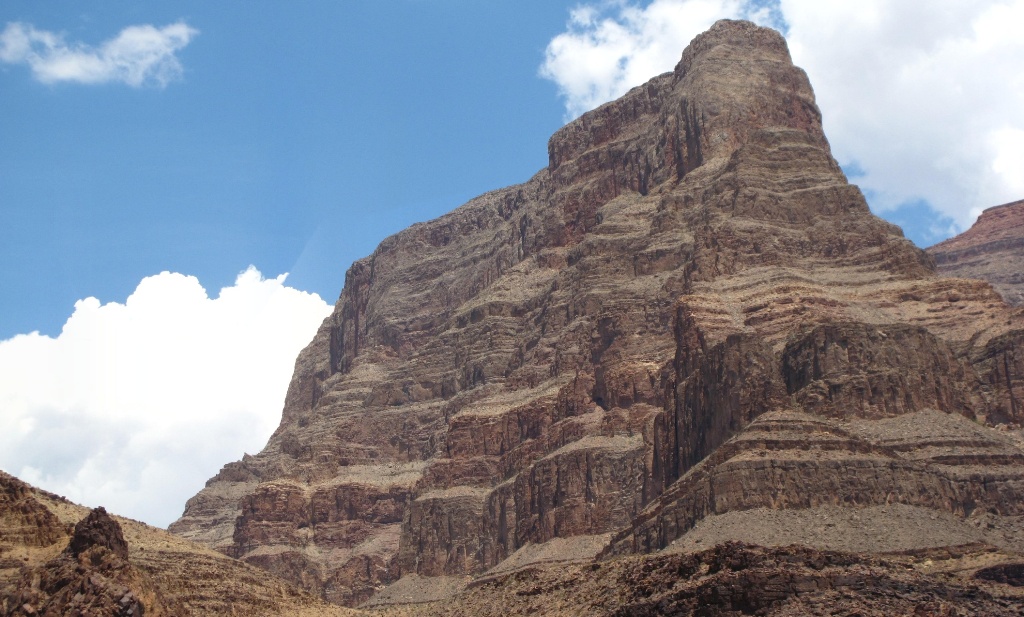| By: Paul S. Cilwa | Viewed: 4/26/2024 Posted: 7/18/2013 |
Page Views: 2291 | |
| Topics: #Arizona #GrandCanyon #Hualapai #whitewaterrafting | |||
| All about the time I took my grandson and his cousins whitewater rafting in Grand Canyon! | |||
So, a couple of days ago, my grandson, Zach's, dad, Jimmy, welcomed his sister, Kelly, and her husband and two granddaughters. That makes them Zach's second cousins. They live in New Jersey, and had never seen Grand Canyon or gone whitewater rafting.
So, of course, I offered to take them. But the only takers were Zach and the cousins, Brianna and Patricia.
Jimmy offered to cover costs and to loan me his GMC Denali for the expedition. Of course I agreed with delight, and we left yesterday afternoon, driving through Prescott and enjoying this sunset just about the time we reached I-40.
Our destination was the Hualapai Nation. The Hualapai are Native Americans whose reservation extends from its capitol, Peach Springs, Arizona, to the south rim of Grand Canyon. Like their neighbors, the Havasupai, they have chosen to support themselves in this desolate yet beautiful land, through tourism rather than casinos.

Thus we arrived at Peach Springs and the Hualapai Lodge about 9 PM. The place looked like any other upscale motel, with a cafe, a gift shop, pool, and exercise room. Our room was clean, with an HDTV (that the kids instantly set to South Park).
We lucked out, numbers-wise, because the Hualapai had a special going: Four people rafting plus a room at the Lodge, and a continental breakfast.
After our long drive, it didn't take long for the kids to fall asleep. I assume; I fell asleep first.
In the morning we had to get up at an ungodly hour. Zach and I declined to shower—after all, we would be wet all day anyhow—but the girls took a little time to make themselves lovely and we grabbed our continental breakfast ("upgraded" to include eggs and bacon, added to the Danish that had been imported from whatever continent Sara Lee bakes on). We then rushed back to our room to pack our non-river gear and load it into the Denali; barely getting back to the door in time to catch the Hualapai bus to the river.

The bus was, basically, a re-purposed school bus. Anything fancier would have been destroyed by the road, and I do not exaggerate. While the first few miles were not so bad, the conditions deteriorated rapidly. The road parallels, and in some places is crossed, by Diamond Creek. We splashed right through the water! The view out the windows grew more and more spectacular as we got closer and closer to the Colorado River, but also harder and harder to photograph because the bus was jouncing so badly. I probably took 30 pictures but had to throw out 25 or so because they came out as multi-colored blurs. Still…after using software to align the horizon, I did manage to save a few…
One of the more interesting plants we have out here is called the ocotillo (pronounced, "ah-ko-TEE-yo"). It consists of spiny branches extending from a common center, and grows beautiful orange blossoms in spring. This wasn't spring, but I still got a nice shot of one as an example.
Diamond Creek is named after Diamond Peak, a triangular-shaped outcropping that can be seen for many miles upstream, long before actually coming to it.
Anyway, after a half-hour or so, we finally reached the river and exited the bus, where we found the Hualapai River Runners had gotten all the rafts ready for the trip, and life jackets laid out in piles. We were assigned Boat #5 and donned our jackets. Here are Patricia, Brianna, and Zach, posing in theirs.
It was still quite early, and although the sun had risen well above the horizon, it was still hidden deep in the Canyon as we were. So it was cool to see it begin to kiss the Canyon's upper reaches as we prepared to shove off.
I needed a little extra help with my jacket, which is very tricky to adjust on oneself. And I'm afraid I settled, not making the waist as snug as it should have been, which caused a bit of an issue later. We were given am ammo case to keep our need-to-be-dry stuff like cellphones.
Our guide, Kesley (spelling is correct), invited us aboard Raft #5 and we were ready to go! And, as you look at the kids' expressions, remember that only Zach had ever been rafting before.
I, on the other hand, have been rafting many times…but not since my bout of necrotizing fasciitis, over two-and-a-half years ago. And I hadn't gone rafting in Grand Canyon since 1996. So I was pretty pumped up!
This was my first motorized rafting trip. We were going to cover some 43 miles in a day. (On an oar-powered raft in Grand Canyon, 20-25 miles in a day is considered pretty good.) However, Kesley led us through one rapid—where he maneuvered so that everyone but him got thoroughly soaked—before pulling off for a morning hike.
This hike was to visit Travertine Falls. I had been there once before, and found climbing up the steep, rounded granite with no support but a rope to be a real challenge to my fear of unsteady heights. (I have no problem with stable heights, like a cliff or a roof.) My fear of looking like an idiot was also challenged.
The first part of the approach is easy enough; here's Brianna posing on it. (Not really posing; she was hiking and I yelled, "BRIANNA!" until she turned.)
But it gets steeper, and a rope has been placed to assist hikers. And even then, it needs the assistance of a river guide to angle it so that it's useful.
This rope used to be the only aid to the top, when I was here last. Fortunately, as you can see in the above photo, they've added a rope-and-wood ladder to the steepest section, the one I had the most trouble with on my previous visit. The ladder made it much easier, and while there was never any doubt as to the kids' ability to scramble to the top, even I was able to make it without the aid of a derrick.
At the top of this hill, there is what looks like a cave from which water gushes. However, this is not the waterfall; and it isn't really a cave because it is open at both ends. It's a grotto, and there's another ladder to assist climbing into it.
By the way, in the above photo to the left, I am not missing a leg. I am wearing a black calf stocking to protect the scars from my necrotizing fasciitis.
So…what do we see when we enter the grotto? An amazing light show, as beams of light peer in from the two openings and bounce against the travertine walls and puddles of water.
And it gets even more beautiful as you continue further in. This is what the designers of cathedrals had in mind, but were never able to duplicate.
Travertine is a mineral deposit, mostly, calcium, laid down by this creek over millions of years of flooding and flowing. It picks up colors from other minerals that are dissolved in the water with it.
The grotto is gently curved, hiding the actual waterfall from view at first, then gradually revealing it until, at last, you stand at it's base, unable to not look upward.
A Hualapai photographer was waiting at the falls to take photos of anyone who wanted one. He took this good picture of the kids, but the shot of me was so awful I didn't buy it, as it kind of made me look like a serial killer who's just hidden a body in a waterfall.
Not the photographer's fault, of course!
The girls went back, but Zach and I hung out, me to take a few more pictures of this stunning waterfall, and Zach to climb it.
It's the nature of travertine that it tends to form very climbable walls. Zach wasn't the only one climbing; and, indeed, I had gone up two or three feet myself on my previous visit. But Zach left no wall unclimbed. And, of course, he had to start with the toughest one, through the waterfall itself.
But, after living in the Phoenix area all his life, and having left it at about 105°, the cool water (not as cold as the river water) was no doubt very welcome.
Walking up to the grotto, I had been so focused on dreading the rope climb, I hadn't thought to look behind me. No matter; on our return—after sliding down the grotto opening in the secondary fall, and climbing back down the ladder (but taking a simpler path, without the rope)—I realized that there was another, typical but precious, view of the river.
Yes, that brown ribbon is the Colorado River. This far downstream from Glen Canyon Dam, the water is always this color, as it was along the entire river's length before the dams were ever built. The name of this color in Spanish is colorado, and was the name given this river when Spanish explorers began exploring the Southwest. The state is named after the river.
Our hike over, we returned to the boats and cast off. As before, we came upon rapid after rapid—only one of which was anything that would have challenged an oar-frame—but Kesley always knew just where to hit for maximum soakage to everyone aboard the raft, but him. That's okay, though, because the kids loved it. And, in between rapids, there were more spectacular views and opportunities to share my interest in geology.
I think it was Brianna who suddenly asked, "What's that noise?" Indeed, there was a roaring up ahead that could be heard over the sound of the motor.
It was our final, big rapid and this one was big. Oh, no Lava Falls (Grand Canyon's most notorious) but still, a definite 7, (Grand Canyon rapids are measured on a 1-10 scale, rather than the more common I-VI scale used on other rivers.)
Kelsey warned us that this one would be rough, and that it might be easier to hold on from within the raft, rather than by sitting on the pontoons. So I took him at his word. The next thing I knew, a tsunami of Colorado water poured into the boat, and pretty much all into my mouth. —Which was not captured by the Hualapai photographer, now on the river, trying to capture hot whitewater action.
Once past the rapids, he took another stab at getting a good shot of everyone in the boat. Note to self: If you want a good raft photo, be sure and sit in front.
But at least the kids were well-represented, as Patricia was clever enough to lean in.
That concluded the whitewater aspect of our trip. It was time to break for lunch, after which we would cover some 20 miles more of smoothwater and scenery.
Yes, it definitely felt good to peel off the life jackets!
Lunch was distributed by the Hualapai guides, who had brought it with us. It consisted of delicious sandwiches (I had ham and cheese), chips, and water and sodas. The kids and I found comfortable rocks to sit on, so we could enjoy our food and the scenery at the same time.
Actually, I was amazed at the number of people who did not eat on shore. They remained on their rafts, seeking safety, I suppose, from rattlesnakes and scorpions they assumed must be crawling all over the place. (In reality, of course, rattlesnakes are very shy and will never hang around where a bunch of people are gathered; and scorpions are active at night so as long as you don't stick a finger under a rock where one is resting, you won't see one in the day.
The Hualapai could not have picked a prettier place for lunch. We were on a promontory that jut out into a curve in the river, so there were different river views on three sides, plus a side canyon behind us. Fast eaters had plenty to see while waiting for their slower chewers.


The side canyon doubled as a lavatory. Easier for the guys to use than the girls, of course; on my previous trips girls generally stepped into the water to relieve themselves. But our guides had actually not said a word about bathroom etiquette ("Boys upstream, girls downstream!") and the girls in my charge didn't ask. Besides, the one downside of our picnic spot was that there was no shallow water to safely step into. So the side canyon was pretty much our best bet.
So, after lunch and local siteseeing, we re-boarded our raft and continued to gaze at the most amazing rock formations, ranging from lava/granite/basalt to sandstone and limestone, sometimes all mixed together in a conglomerate.

I've been told that all the formations have names; many have more than one as they've been identified by more than one person, each unaware of any previous monikers. But some of the formations are so obvious that you can almost guess at the name and be right. Below, for example are The Three Sisters. (The third sister is really short.)
I was particularly taken with this sandstone outcropping, which I named The Anvil. (It looked more like one when I first noticed it, but by the time I could get the camera ready we had passed the optimum photo angle. Still…should you ever go by this area, and you notice this formation, be sure and tell everyone it is called The Anvil. That's how you get these names to stick.
Besides me and Kesley, there was one other adult male on the raft. Nice guy, but he never quite seemed to grasp the scale of the place. He had done his homework and knew about the Anasazi granaries (which are far upstream), and kept pointing to this or that limestone niche in the distance, asking Kesley if that might be a granary. I've been to the granaries, and they are about the size of a modern 5x5 storage unit, though not so tall. The limestone niche in the photo below is about the size of a grand ballroom, but he kept thinking it must be small since it looked nearby to him.
The niche in question is shaped like a sideways parenthesis, and is dead center in the photo. It's also probably a mile or more from the boat.
So we reached a stretch of flatwater and Kesley announced that we could swim if we wanted. By now it was pretty warm and the idea of a dip, even in 50° water, sounded delightful. So I jumped in, immediately followed by Zach, Patricia and Brianna. (The other family did not indulge.)
It wasn't until I was in the water, that I learned that Kesley did not have a means for getting back into the raft.
The motorized rafts ride a lot higher in the water than the oar-frames I am used to. With those, a good kick and you're halfway in the boat; anyone handy then tugs on your life jacket and you're the rest of the way in. Not here, though. Kesley tried to pull me up by the straps, but because the waist wasn't as tight as it should be, the jacket just pulled over my head. We tried it from the stern as well as the bow. Finally, I found a place on the motor that wasn't too slippery, put my foot there, put my back against a pontoon, and forced my way up like a rock climber between two sheets of rock until I was close enough to be pulled the rest of the way.
I got in, but when I asked Kesley why they didn't have a little rope ladder, he said it would be too big and heavy. I was thinking one with, like, ten rungs; but, whatever.
After the excitement of being landed like a tuna, Kesley passed out an afternoon snack of cookies and chips.
And then, finally, we reached Grand Canyon West, the Hualapai's hub for tourism. Or, rather, we reached the river below it. We got off the raft at a real dock, and climbed a rock staircase to a clearing large enough for three helicopters to land at once.
There were no signs so it took a few false starts before we figured out where to check in. They had to weigh us with our stuff, so as not to overload the helicopter. It was gratifying to learn that I've lost enough weight since my last helicopter ride, that no one urged me to buy extra flight insurance.
All three kids were excellent travelers, dealing well with delays and such. Which was a good thing, because despite having six helicopters at their disposal, three of which could land at a time, there were so many rafting passengers as well as tour boat passengers, that we had to wait over 20 minutes for our turn.
And there wasn't a single complaint from any of the kids, who used the time to play with their phones or simply enjoy the view.
Presently, the manager of the helicopter operation called us ("Raft number 5!") and we stood a few yards away as our chopper landed.
Passengers were moving both ways; so we had to wait for the previous occupants to exit before we could board.
They loaded all four of us in back, with three passengers and the pilot in front.
As we ascended, and looked down on the river, watching it seem to shrink, I was reminded of García López de Cárdenas, head of the small contingent of the first Europeans to see the Grand Canyon. Cárdenas, who apparently suffered from the same inability to perceive scale as my raft-mate, was unimpressed, assuming the Colorado River to be about six feet wide. (He also thought the Canyon was about 300 feet deep. It's actually about a mile.)
It only took about five minutes to climb to the rim.
We landed without incident and headed to the Grand Canyon West complex to wait for the photos taken by the Hualapai photographer to be made available, and then to catch our bus back to Peach Springs.
They took forever getting the photos ready. They were digital, so I don't know what the holdup was. True, there were a lot of photos to present. The photographer had been with us all the time—I think he was also a river guide—and had taken many photos. Sadly, he hadn't quite mastered whitewater photography. Several pictures would have been very exciting if they'd been taken one-tenth of a second sooner. Instead, they were simply photos of splashing water, with the boat and passengers completely obscured.
They do have a nice way of selling them, though. You can either pay for a print, or buy a $5 flash drive with the photos you select; and those photos are just under $10 each. You can buy the entire set for $133, but that will be pictures of everyone on all the rafts, none of whom you know. I bought three pictures, on the flash drive, so the cost was quite reasonable.
I also got Patricia a dream catcher she liked, as a souvenir. Brianna couldn't find anything she liked, though. (And later, I got Zach a wooden flute.)
I also picked up a couple of cool T-shirts and a Hualapai River Runners ball cap.
Our bus was air conditioned, which is good because it took two-and-a-half hours to return to Peach Springs.
Before we arrived, Zach's mom, my daughter, Jennifer, called.
"I'd be more comfortable if you stayed another night,"
she said.
"Then leave in the morning."
I agreed, because I had hoped to take the kids on a little more sightseeing before we got back. I learned later than Jenny thought we would have to drive the Denali over the rough Diamond Creek road in the dark, not realizing that the Hualapai Lodge, where the bus returned us, is right on Route 66.
And we lucked out. The lodge had exactly one room left, which we got. After unpacking (again) and having an awesome dinner in the Lodge cafe, and after the kids spent a little time working off steam in the exercise room, we turned in, promising each other to sleep in late, before continuing on tomorrow's adventure: Seeing Grand Canyon from the Rim.





